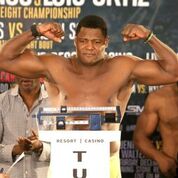By Bart Barry

Among the very few benefits of the PBC’s 2015 emergence is this: We now know clarity in prizefighting’s flagship division – heavyweight, according to legend – assures the longterm health of our beloved sport exactly not at all. Having a unified heavyweight champion for the last few years did nothing to defend us from what existential threats attacked in 2015.
That means Saturday’s match between Cuban Luis Ortiz, who, despite growing to 6-foot-4 in the world’s best amateur-boxing program, we’re told by his trainer, confronts more hardships than a Thomas Hardy heroine, and American Bryant Jennings was inconsequential as it was entertaining. Ain’t nothing wrong with that.
Last week I watched Chasing Tyson, an ESPN documentary that concludes with Tyson concluding Evander Holyfield is among the five greatest heavyweights of all time, or top three. There’s a touch of selfaggrandizement in that, and everything Tyson says, but Tyson’s rather substantial point is not missed: Holyfield is underrated. Possibly. He made quite a lump of cash for a man who didn’t get his due, and as a boxer-puncher who migrated from cruiserweight, he was not destined for what raucousness attended Tyson’s ascent and reign and descent and clutch of nostalgia tours (San Antonio’s performance of Undisputed Truth, despite HBO’s sponsorship, was cancelled for lack of ticketbuyers).
It was a nostalgia tour of my own that put me before the documentary: The late eighties and early nineties were the time I enjoyed boxing most for understanding its business least. Young prizefighting fans, or sportsfans generally, likely cannot imagine this, but there was an epoch when you knew almost nothing about your favorite prizefighter but his record and tapemeasurements – just like you knew almost nothing about your favorite Major Leaguer that wasn’t oppositeside his photo on a small piece of cardboard.
Memorizing purse sizes and opponents-avoided and broadcasting networks, these things, seemingly so essential today, were not what a young aficionado did. Probably a few kids incorporated perceived pieces of their favorites’ personalities in their identities, but mostly it was not a fulltime endeavor, or if it was you outgrew it. While the five minutes given to sports on your local nightly newscast gave you a fight result, accompanied by still photos or drawings from ringside, you didn’t learn anything definite about a heavyweight title fight till Sports Illustrated arrived the following Thursday.
What about Tyson on HBO? Cable didn’t even come to our town till Tyson’s reign was underway, and there was no way my father was going to pay more for a movie channel than the network broadcasting Red Sox and Bruins games.
A goodish amount of the superfights of the Tyson era, then, happened in one’s imagination before he got a tape of the fight in his family’s VCR a month later, and if I might be forgiven the blasphemy, I’m fairly certain that in maintaining this substantially greater distance between athlete and fan, things were healthier, less intimate, less urgent. If your favorite lost, you talked about it for a day or two, the novelty dissipated, and life marched right along.
What struck most about Chasing Tyson, and here is where we meander back to current events, was how sensationally more athletic those guys were than the beasts who lumber about at the end of the Klitschko Era. Persons who like to know things, who fetishize the number of data they carry about in their heads – a metric dated brutally by the billions of things any five-yearold with an internet connection can now “know” in a halfminute of searching – multiply height and reach and weight and quickly conclude today’s heavyweights are the most dominating that have peopled prizefighting’s purpled plains.
Nonsense. Watch the speed and craft shown by Evander Holyfield and Riddick Bowe, and know the James “Buster” Douglas who fought Tyson in Tokyo would race through most of the top heavyweights today, regardless of their height and reach advantages, and Douglas is as much a trivia question now as he was a punchline back then.
That is not to detract, quite, from Saturday’s HBO fare, a main event that saw Ortiz win the proper way, knocking the stuffing out of Jennings, another American in the athlete-cum-fighter line, a man who tried his hands and feet at lots of other sports till he was too old to make money at them then began boxing at age 24 (where he eventually lost the 2009 Golden Gloves title to a heavyweight now calling himself Cam F. Awesome [who’s actually a breathing synonym for “composure” in a fight]).
Ortiz is better schooled than Americans because he came of age in an excellent system, learning from men who fed their families by teaching boxing, not hobbyist dads holding stopwatches and yelling “give me ten more!” under the auspices of discipline or conditioning, or vicariousness. When he flows, Ortiz sort of resembles a prizefighter from any weightclass other than heavy, and that is high praise indeed.
A thought experiment that bears repetition: Imagine Wladimir Klitschko reduced by a foot and 100 pounds and set across from a prime Juan Manuel Marquez or Manny Pacquiao. For how many rounds would Marquez or Pacquiao toy with him before dropping the black curtain – two? three? There was a time, the one captured in Chasing Tyson, when heavyweights were very large versions of middleweights, when you might imagine a Holyfield or Tyson, shrunken by some inches and 50 or so pounds, stresstesting Floyd Mayweather’s defensive wiles to Emergency. Contrarily, for a snicker imagine one of today’s heavyweight titlists, Deontay Wilder, six inches and 60 pounds smaller and set across from Andre Ward. Then keep the mirth rolling by imagining a 112-pound man with Tyson Fury’s toolkit pitted against Roman Gonzalez.
Let us have no more loose talk about today’s heavyweight prizefighters belonging on pound-for-pound lists, whatever gaudy win streaks they enjoy. They are genetic lottery winners, each and every, and that’s enough – we don’t have to call them great at boxing, too.
Bart Barry can be reached via Twitter @bartbarry











